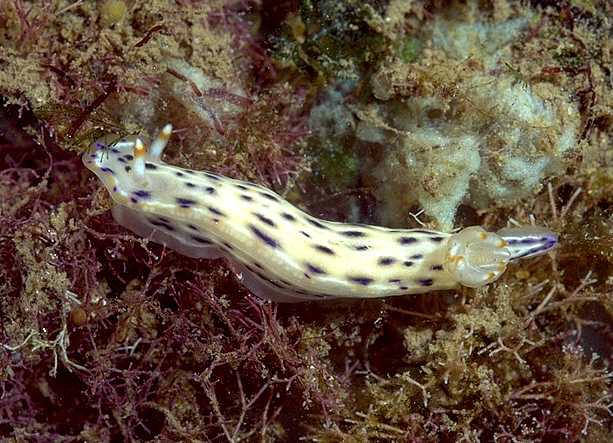 |
Hypselodoris bertschi
Photo Courtesy of John Hoover, Honoulu, Hawaii
Hypselodoris bertschi Gosliner & Johnson, 1999
Family Chromodorididae
This recently described species of Hypselodoris was identified
as H. lineata in several previous publications, including Hans
Bertsch's own book, Hawaiian Nudibranchs. Little did he know it
would eventually be named after him! The slug is light in color,
marked with dark purple longitudinal streaks and spots. Between
these "dots and dashes" meander fine longitudinal lines of
bright frosty white. The rhinophores are bisected by an orange
band and the gills show spots of orange. It attains about
1 in. (most are smaller) and is known only from the Hawaiian
Islands. Around O`ahu it is probably the most common species
of Hypselodoris, occurring in both exposed and protected
locations. It was named for Hans because of his extensive
contributions to our knowledge of opisthobranchs, especially
those from Hawai`i.
Photo: Magic Island boat channel, O`ahu. 10 ft. (3.2 m)
May, 1999
Citation
Terrence M. Gosliner and Rebecca F. Johnson, 1999. Phylogeny of
Hyselodoris (Nudibranchia: Chromodorididae) with a review of the
monophyletic clade of Indo-Pacific species, including descriptions of
twelve new species.
Zool. Journ. Linnean Soc. 125:1-114, with 62
figures.

"...From December 1997 through September 1998, I participated in a research project sponsored by the Mexican federal agency CONABIO (Comisión Nacional para el Conocimiento y Uso de la Biodiversidad). The project was entitled: "Biodiversidad de Moluscos Opistobranquios (Mollusca: Opisthobranchiata), del Pacífico Mexicano: Isla Cedros-Vizcaino e Islas del Golfo de California parte sur." This grant was given to the Universidad Autónoma de Baja California Sur, under the directorship of Carlos Armando Sánchez Ortiz, with myself being named the Investigador Asociado (experto), that is, wow, The Expert Associate Investigator. The field work was completed by myself and colleagues from the UABCS, Orso Angulo and José Luis Arreola. |
Our project basically had two major emphases: a study of the opisthobranch biodiversity in the area of Punta Eugenia (including Bahía Tortugas and Isla Cedros), and museum data collection.
The biodiversity study has already resulted in electronic and journal publications; in preparation is a manuscript detailing 10 species of opisthobranchs that we found (either subtidally or intertidally) which have never before been found from the Pacific coast of the Baja California peninsula. These significant results from just six sampling expeditions have encouraged us to ask for a renewal of the grant. This region obviously needs a longterm biodiversity study. Moreover, our observations and collections were done during an El Niño condition.
The museum data collection was a survey of the holdings of California
Academy of Sciences, Los Angeles County Natural History Museum, and the
Santa Barbara Museum of Natural History. Officially titled "Repatriación
de los Datos," we were looking for all Mexican Pacific coast opisthobranch
specimens in these museums; we recorded the collecting data of the
material, and sent this information to the main files of CONABIO; they now
have a data base in Mexico of over 1500 lots of Mexican-collected
opisthobranchs that are deposited in the major US Californian museums.
We are looking forward to the renewal of our project, and our continued
work in the Bahía Tortugas region..."
Imperial Beach, Calif
May, 1999
